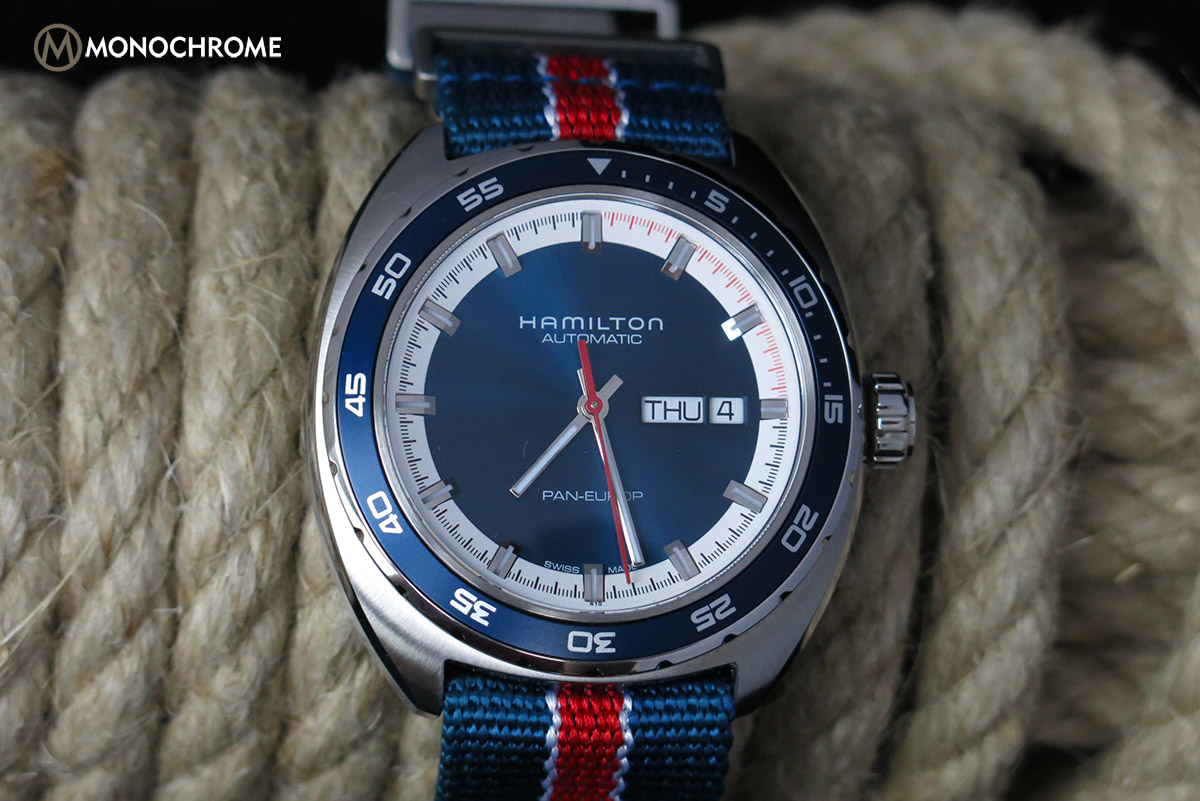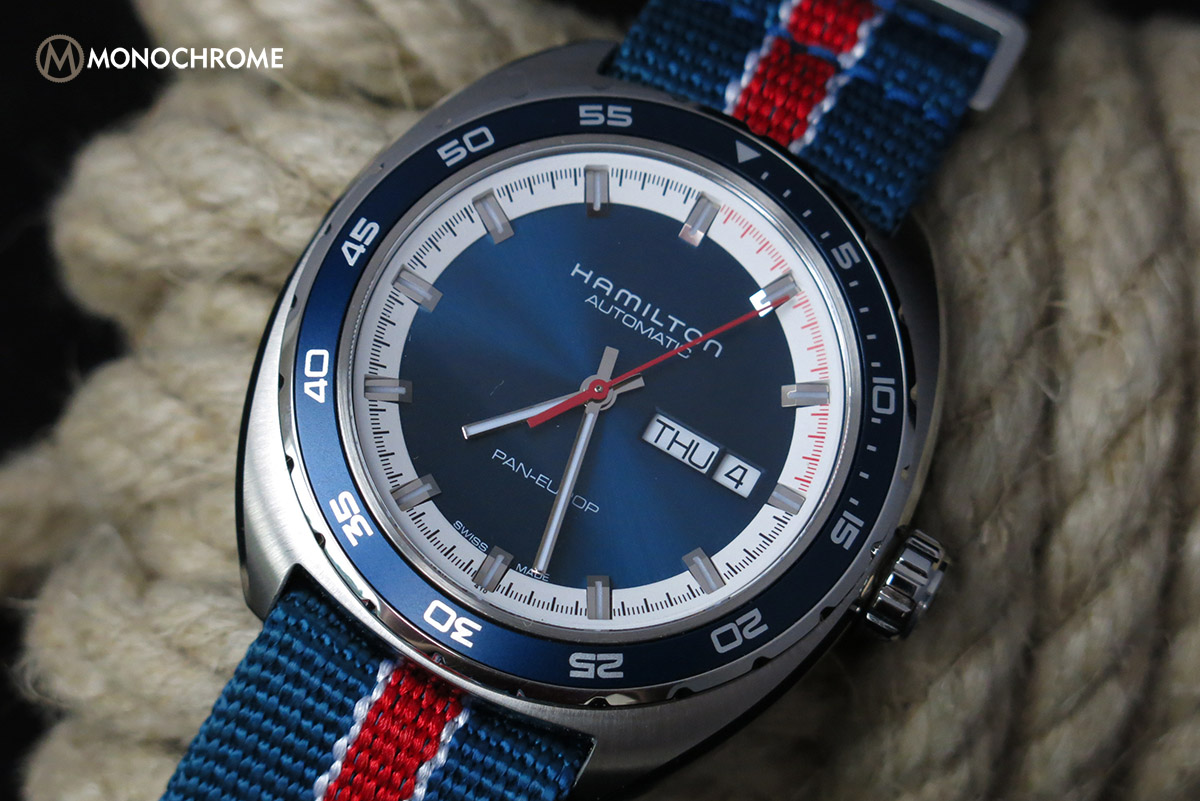Hamilton Pan Europ Automatic – Full Review (Live photos, specs and Price)

The Jackson 5, ABBA and Queen. The Godfather, Bruce Lee and Star Wars. Platform shoes, sideburns and bell-bottomed pants. The Royal Oak, Nautilus and Ingenieur. All of them first saw the day of light during the seventies, and in the watch industry, this era seems to be making a comeback when it comes to design. The original Hamilton Pan Europ was introduced in 1971 and in recent years they’ve brought it back to life. The Chronograph version was redone and re-issued in 2011, and for 2014 there is a non-chronograph available. We go hands-on for a review with the seventies inspired looker.
Hamilton, as a brand, dates back to 1892 (no connection to a bloke named Lewis Hamilton, as many people tend to ask me). Among the accolades of the brand are the pocket watch from 1912 ensuring railroad accuracy in the United States, and the 1957 Hamilton Ventura, the first electric watch available to the public. The latter is also famous for being Elvis Presley’s watch of choice for the 1961 movie “Blue Hawaii” and features in the Men In Black movie-franchise.

As mentioned, the original Hamilton Pan Europ was one of the very first automatic chronographs, and was introduced in 1971, featuring the cushion shaped case. The layout of pushers and crown was similar to other iconic chronographs of that era, such as the (Tag) Heuer Autavia or Silverstone or the Breitling Chrono-Matic (crown at 9, pushers at 2 and 4 o’clock), as all of them were coming with a Heuer-Breitling-Hamilton Calibre 11.

Features
The Hamilton Pan Europ is equipped with a simple but reliable movement that provides an indication of hours, minutes, seconds, day of the week and date. For most people, this more than enough information on the wrist, but there is the option for the Chronograph version if time-measuring is needed – or something that you like. The Pan Europ is also coming with a rotating bezel, marked with a diver-style minute-track. However, it should not be regarded as a real diving instrument with its 50m water resistance.
The total package of the Pan Europ is well executed. Two straps (and the tool to change them), one of which is an absolute winner, crisp lines a good build quality, all for a very approachable price point.

Dial and hands
One of the first things you are hit with is the very rich shade of blue that features throughout the watch. The very fine sunburst effect makes the dial come alive, and gives the Hamilton Pan Europ a very distinct appeal. We’ve seen it before in the Girard Perregaux 1966 and the Glashütte Original Seventies Chronograph Panorama Date and it works very well. The day and date window lack a surrounding ring around the aperture, which would have brought the dial up another notch in terms of finishing and detailing.

Surrounding the blue dial is a white chapter ring, with minute markers all around. The first quarter of the chapter ring, between 12 o’clock and 3 o’clock is in red while the rest is in black. The chapter ring also gives away space to the wedge-shaped hour markers with applied luminous material. The straight hands (hours and minutes at least) also feature luminous material, though I have seen brighter examples.
To finish off the dial, Hamilton has opted for slender, inconspicuous markings, only depicting “Hamilton”, “Automatic”, “Pan Europ” and “Swiss Made”.
Case and straps
The 42mm steel, cushion shaped case of the Hamilton Pan Europ is reminiscent of the 70’s racing chronographs and features brushed surfaces and polished edges. At 10.41mm, the new Pan Europ is not quite as thick as last year’s chronograph version (owing no doubt to the slimmer, non-chrono movement). The polished bezel, with an aluminum insert in blue, also feels sturdy. It rotates counterclockwise with 120 sharp clicks.

The crown is adorned with polished Hamilton “H” on a brushed surface. The knurled edge of the crown is polished as well. The integrated lugs ensure a tight fit of the strap and curve down for added comfort while wearing. Both on the front and the back, Hamilton opted for a sapphire crystal over the dial and in the screw-down caseback to allow a view onto the movement.
The Hamilton Pan Europ comes with two 22mm wide straps. The black leather racing-style strap, with a red lining, is very soft and comfortable albeit a bit too slim. The Omega-style folding buckle, tucking in the nib underneath the other end of the strap, uses a small pin to hold onto the strap. Due to the thinness of the strap it sometimes rotates slightly while wearing and the nib of the strap ends up poking out from under the buckle.

The included blue and red NATO strap is a true gem though, and shows care and attention into this sometimes overlooked part of the watch. Matching it in terms of color emphasizes the 70’s feel. The end of the strap is finished with a steel nib including the Hamilton-logo, the rings are squared for a tight and easy fit of the strap, the buckle is sturdy (again with the Hamilton) and the hole-section of the strap is reinforced with a leather strip. The fit and feel of the strap is superb, and perfectly emphasizes the 70’s racing feel.

Movement
While the original Pan Europ was equipped with a chronograph movement, the well-known Caliber 11, the current non-chrono version houses the Hamilton H30 movement. Basically, it is an ETA 2824 automatic movement with an upgraded mainspring, boosting power to a very ample 80 hours. Being part of the Swatch-group since 1974, Hamilton is safe from the fact that ETA is cutting down supplies to third parties, as we all know.

The see-through caseback is a nice addition to the overall presentation. Despite the fact that the original Pan Europ had a closed one and the choice of movement doesn’t exactly make it a necessity, there is always something appealing about being able to see a movement tick. Although not the most handsome movement, the rotor has been customized with an open-worked “H” and “Hamilton”-engraving. It features hours, minutes, seconds, weekday indication and date functionality (both with instant jumps at midnight).

The day and date indication can be individually set through the crown, by pulling it out one step and turning it one direction for the day and the other direction for the date. Pulling it out one more step allows you to set the time of course.
Pros and Cons
Pros:
- Authentic seventies feel with historical inspiration
- Well executed NATO-strap uplifts the watch
- Very strong value for money proposition
- Reliable, adequate movement
- The 80h power-reserve
Cons:
- Lacking refinement keeps it from excelling above its price bracket
- Flimsy feeling leather strap, poking out from under the buckle
- The modest water resistance

The Hamilton Pan Europ is available in two versions, the blue dialed one we covered here and a version with a grey dial and bezel with corresponding NATO strap. The leather strap is the same for both models. Hamilton has succeeded in giving us a watch that oozes “seventies” and is historically significant. Combining that with a price tag of € 895.00 Eur including taxes makes this a watch to consider spending for your hard earned money within this price-bracket.
For more information regarding Hamilton watches, or the Pan Europ collection in particular, please head over to their website.






















3 responses
Hamilton watches have been my choice for knock-around watches and general abuse. Even after their recent rise in popularity (and price) over the past five or six years they still offer great value and nice styles. I can live without some of their larger pieces but for the most part not bad for the price.
The movement is not a modified 2824, it is the Hamilton branded version of the new ETA C07.111 which is best known from the Tissot Powermatic 80.
@Stealth, you’re right, it is the same movement than the Tissot Powermatic 80. But we have to be clear, the base movement is really an ETA 2824, modified with a new main spring and a reduced frequency (3Hz instead of 4Hz) and a new escapement.